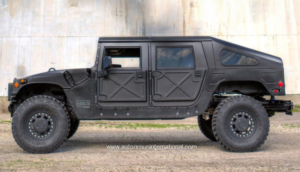The Humvee first came to public attention during the first Gulf War, when rolling 24-hour news coverage frequently featured the military vehicle whisking service members across vast deserts or through dangerous city neighborhoods. Over time, the HMMWV became known for being slow and clumsy, prone to rollovers, and easy prey to roadside improvised explosive devices. Click https://www.streetlegalexports.com/ to learn more.
The Humvee is the Army’s version of a 4×4 car/light truck hybrid. Big, boxy, and with a wheel at each corner, it’s the perfect blend of no-nonsense practicality and combat expertise. It’s the vehicle that helped the US military steamroll Iraq’s defenses both times they attacked.

It also carries wounded soldiers to safety and cargo across the desert and through cities, and it is capable of performing in a wide range of conditions, from jungle to desert. It supplanted the jeep and other vehicles, including the 2-ton M274 Mule and 6-wheel-drive 1-ton M561 Gama Goat, all of which were past their prime at the time of the Humvee’s introduction into service.
The Army wanted a versatile, easily maneuverable vehicle that could be airdropped to the battlefield and used by several branches of the service, so it decided to militarize civilian trucks. It began by purchasing commercial jeeps and converting them to meet its requirements, but the results weren’t good enough. The new design would have to be able to carry more weight, handle more difficult terrain and protect its crew from enemy fire.
In 1981, the Army issued a request for a new, multipurpose wheeled vehicle. It was called the High Mobility Multipurpose Wheeled Vehicle (HMMWV), but it’s best known as the Humvee.
The basic Humvee is a transport and personnel carrier, but it can be equipped with a variety of weapons systems and other equipment. It has four-wheel drive and is much larger than a jeep, measuring 6ft tall by 7ft wide and 15ft long.
It has a strong aluminum body, which is lighter than steel and resists corrosion. It also has independent front and rear suspensions that give it the ability to travel over terrain that would stop most other vehicles in their tracks. Unlike the jeep, it has a fully enclosed cabin to provide protection against enemy fire.
While there are dozens of different variations of the Humvee, they all have some things in common. For example, each has 44 interchangeable parts that make it easy to repair or replace any part that goes bad, which keeps maintenance costs low and ensures the vehicle is available for deployment when needed.
Although the Army will probably never retire its Humvee fleet, it has introduced some new models to supplement it. The most recent, the HMMWV SABER, is designed to be more fuel efficient and protect its crew from roadside bombs and rocket-propelled grenades. It’s probably unlikely that this more streamlined, less expensive vehicle will enter mainstream Army and Marine Corps service, but it could be adopted by other nations who already use the original Humvee. It is also expected to be offered to private companies for use in the military and for civilian applications.